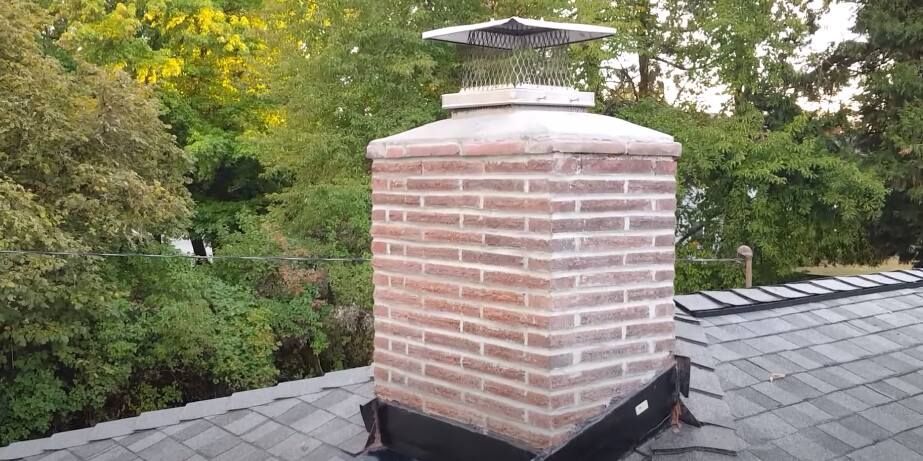Why Do Chimneys Need Tuckpointing?

Chimneys constantly face the harsh elements – rain, snow, freezing and thawing cycles, and even heat from the fires within. Over time, this exposure wears down the mortar between the bricks or stones. Tuckpointing fixes this by removing the damaged mortar and replacing it with fresh material. This strengthens the chimney's structure and improves its appearance.
Tuckpointing is essential to
prevent water from seeping into your chimney. Water damage can lead to mold, wood rot, and even structural collapse. A well-maintained chimney, including tuckpointing when needed, helps safeguard your home's safety and value while extending the lifespan of the chimney itself.
Is Tuckpointing Necessary?
Tuckpointing is a crucial process that serves multiple purposes. Firstly, it helps prevent corrosion in mortar joints. Corrosion in mortar joints occurs when carbon dioxide from the environment gets into the mortar and causes carbonation, leading to a change in the pH of the mortar.
Secondly, tuckpointing can help reduce costs. It prevents excessive deterioration of your chimney over time, which would result in having to rebuild it. Rebuilding involves a couple of processes, including tearing down the chimney, buying new materials, and redoing the structure, which can be expensive.
Tuckpointing is also crucial because it helps restore the structural stability of your chimney. If the mortar joints of your chimney are in poor condition, your chimney's structure becomes weak and eventually begins leaning on one side. The chimney may even collapse in some cases.
Additionally, tuckpointing prevents certain elements, like water, from entering your chimney system. Water causes a lot of damage, including weakening the mortar joints. Tuckpointing also helps reduce the risk of chimney fires by eliminating gaps in mortar joints that allow sparks to escape and cause unwanted fires. Lastly, tuckpointing improves the value of your home by ensuring your home's masonry is in great condition.
What Are the Signs That My Chimney Needs Tuckpointing?
Various signs can indicate your
chimney needs tuckpointing. A discolored mortar is one of the most common signs. The mortar may start losing its color due to weathering. A rusted damper or firebox may also signify that it's time to schedule a tuckpointing service. It is worth noting that rusting occurs when there is a water leak in your chimney.
Additionally, if you notice flakes in different parts of your mortar, booking a tuckpointing session would be ideal. This is because flakes indicate that your mortar has aged and weakened. Also, tuckpointing is essential if there are loose bricks on your chimney. The loose bricks signify that the mortar is unable to hold the bricks together.
Another sign you need to look for is the existence of cracks in your chimney. The cracks usually indicate that your mortar has deteriorated. Also, prompt action is usually essential when the recession of your motor has gone towards the center of the chimney by a quarter, half an inch, or more. Also, if you notice that your mortar easily crumbles when there is a small impact, tuckpointing is essential. Lastly, if you notice immense mold and mildew growth in different parts of your chimney, tuckpointing may help mitigate the problem. Mold and mildew grow in areas with high humidity, so their growth in your chimney shows there is water leakage in the chimney.
How is Tuckpointing Done?
The first step is usually identifying the parts of your chimney that need tuckpointing. Afterward, the existing mortar joints are removed to a uniform depth, usually to about one inch, using any object of choice. Most people use an angle grinder. However, a hammer or chisel can also get the work done.
After removing the old mortar, the debris and dust left in the spaces are cleaned off with a high-pressure air nozzle or a brush. The mortar is then mixed to match the color of the mortar that was previously there. This ensures the mortar matches the brick's color. The new mortar is then added to the joints, starting with the horizontal ones. In this step, a lot of care is put into ensuring that the mortar does not spread all over the bricks and that the repaired area is left looking neat.
After filling the joints with the mortar, the mortar is smoothened to resemble a flat surface or any other shape, depending on what you want. The mortar is then left for a while to a point when it begins to harden but is still semi-pliable. A straightedge and a tuckpointing tool are then used to form straight lines in the middle of the mortar to create grooves. The lines are usually made to be as straight as possible. Lime putty is then applied on the lines to develop contrasting fillets. The excess mortar is then cut away. Different professionals use different tricks when it comes to
tuckpointing. So, the procedures and materials may differ slightly depending on the professional doing the work.
What Should I Do If I Notice Sign of Chimney Deterioration?
There are instances where signs of chimney deterioration signal that tuckpointing is needed. However, there are other signs that indicate a complete rebuild is necessary. So, if you notice any signs that signify your chimney is not in good condition, contacting professionals will be best. They will inspect the condition of your chimney and give you the correct recommendations for the type of work that needs to be done to restore it to its original working state.

